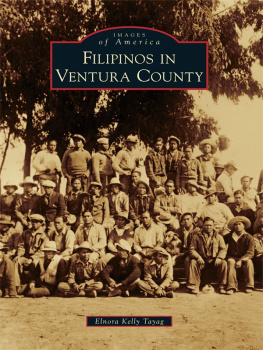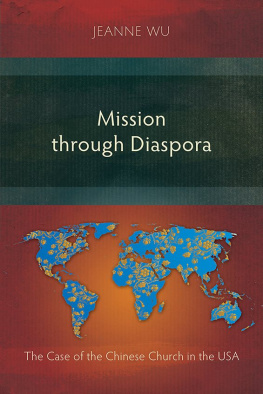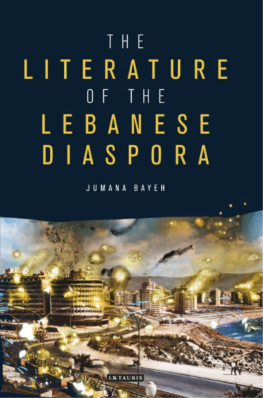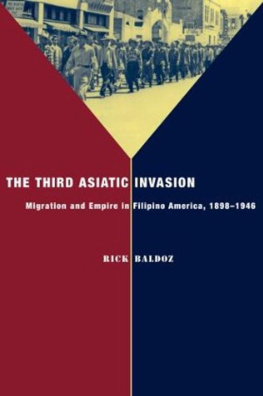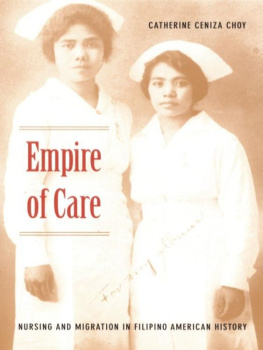ASIAN AMERICANS
RECONCEPTUALIZING CULTURE, HISTORY, POLITICS
edited by
FRANKLIN NG
CALIFORNIA STATE UNIVERSITY,
FRESNO
Asian Americans: Reconceptualizing Culture, History, Politics
Franklin Ng, series editor
The Political Participation
of Asian Americans: Voting
Behavior in Southern
California
Pei-te Lien
The Sikh Diaspora:
Tradition and Change in an
Immigrant Community
Michael Angelo
Claiming Chinese Identity
Elionne L.W. Beiden
Transnational Aspects of
Iu-Mien Refugee Identity
Jeffery L. MacDonald
Caring for Cambodian
Americans: A Multidisciplinary
Resource for the
Helping Professions
Sharon K. Ratliff
Imagining the Filipino
American Diaspora:
Transnational Relations,
Identities, and Communities
Jonathan Y. Okamura
IMAGINING THE FILIPINO AMERICAN DIASPORA
TRANSNATIONAL RELATIONS, IDENTITIES, AND COMMUNITIES
_____________
JONATHAN Y. OKAMURA
Copyright 1998 Jonathan Y. Okamura
All rights reserved
Library of Congress Cataloging-in-Publication Data
First published by Garland
This edition published 2011 by Routledge
711 Third Avenue, New York, NY 10017, USA
2 Park Square, Milton Park, Abingdon, Oxon, OX14 4RN
Routledge is an imprint of the Taylor & Francis Group, an informa business
Routledge is an imprint of the Taylor & Francis Group, an informa business
Okamura, Jonathan Y.
Imagining the Filipino American diaspora : transnational
relations, identities, and communities / Jonathan Y. Okamura.
p. cm. (Asian Americans : reconceptualizing culture, history, politics)
Includes bibliographical references and index.
ISBN 0-8153-3183-5
1. Filipino AmericansEthnic identity. 2. Filipino Americans Cultural assimilation. 3. Filipino AmericansSocial conditions. 4. ImmigrantsFamily relationships. 5. Filipinos Foreign countries. I. Title. II. Series.
For Cynthia and Micaela, and my parents, Robert and Jean Okamura
Contents
Chapter 1
Introduction
Chapter 2
Diaspora as Transnational Social Construction
Chapter 3
Filipino Americans as the Marginalized Minority
Chapter 4
Beyond Adaptation: Immigrant Filipino Ethnicity in Hawai'i
Chapter 5
Writing the Filipino Diaspora in Hawai'i
Chapter 6
Siting the Filipino American Diaspora in Space, Time and Ethnicity
Chapter 7
Imagining the Global Filipino Diaspora
Preface
In this book I contend that Filipino Americans should be viewed as a diaspora, rather than only as an ethnic minority, because of their significant transnational relations with their homeland that differentiate them from other ethnic minorities in the United States. Encompassing cultural, economic and social linkages, these transnational relationships are socially constructed, that is, they are developed and maintained through various cultural practices engaged in by Filipinos in diaspora. I argue that a diaspora consists of the transnational relations that connect people in overseas communities with their homeland or other cultural center rather than being a dispersed people or the dispersal of that people. Given Paul Gilroy's observation that the concept of diaspora is undertheorized, my modest contribution to its theoretical advancement in Imagining the Filipino American Diaspora is to propose that a diaspora represents a transnational social construction, that is, it is transnational in scope and is socially constructed through the individual and collective actions of immigrants/migrants.
Sole authorship of a book unfortunately conveys the impression that it is the product of one's individual efforts alone. Such is not the case, and I would like to acknowledge with appreciation the assistance and support provided me towards the book's production. I especially would like to thank Franklin Ng for expressing his strong support for publication to Garland Publishing and for encouraging me to work on it. I also owe special thanks for their critical reading and helpful comments of various chapters to Mary Yu Danico, Rod Labrador, John Rosa, and Steffi San Buenaventura.
I express dios ti agngina unay/maraming salamat to friends with whom I regularly discuss Filipino, Filipino American, and race and ethnicity issues and who therefore have contributed directly or indirectly to the writing of this book: Amy Agbayani, Dean Alegado, Leonard Andaya, Cristy Castillo, Candace Fujikane, Bion Griffin, Noel Kent, Christine Quemuel, Britt Robillard, Karen Umemoto, and Geoff White. My writing also benefited immensely from the musical accompaniment of the Beatles, Miles Davis, the Grateful Dead, Keith Jarrett, Pink Floyd, and Neil Young whose music has been with me during the past thirty years.
Grateful acknowledgement is made for the permission granted to republish various articles. Chapter three was originally published in Cultural Diversity in the United States, Bergin & Garvey, 1997, an imprint of Greenwood Publishing Group, Inc., Westport, CT. Part of chapter three also was originally published in Filipino Americans: Transformation and Identity, pp. 188192, copyright (c) 1997 by Sage Publications, Inc. and is reprinted by permission of Sage Publications, Inc., Thousand Oaks, CA. Chapter four was originally published in The Filipino American Experience in Hawai'i, a special issue of Social Process in Hawaii, vol. 33, 1991, and chapter five in Filipino American History, Identity and Community in Hawai'i, a special issue of Social Process in Hawaii, vol. 37, 1996. Chapter six was originally published in Privileging Positions: The Sites of Asian American Studies, Washington State University Press, 1995, Pullman, WA. All of these chapters, including their titles, have been revised to varying degrees for this book.
Imagining the Filipino American Diaspora
CHAPTER ONE
Introduction
The chapters in this book span a research period of eighteen years beginning in 1979, when I began my dissertation fieldwork in anthropology with post-1965 Filipino immigrants in Honolulu, to fall 1997 as I completed the writing of several chapters. Considered together, they reflect my rethinking of Filipino American immigration, cultural practices, community organization, and identity construction. My interest in viewing Filipino Americans and other overseas Filipinos specifically as a diaspora, rather than as an immigrant or ethnic minority, began in 1987 when I read an article in a Philippine news magazine (Midweek) on The Filipino Diaspora in Europe. My research interests in Filipinos and the Philippines had led me to spend three years in the mid 1980s teaching at a Catholic university in Manila and conducting research on the Hanunuo Mangyan indigenous minority on the island of Mindoro and on other topics.
Prior to that time I had begun to meet Filipinos in far flung corners of the world such as Hong Kong, London and Belau. I had gone to the latter tiny island republic in the remote western Pacific in the summer of 1983 to teach a University of Hawai'i extension course. After landing on the weekly flight from Guam, I went to have lunch at one of the few restaurants in the capital town of Koror, and to my great surprise a young Filipina came to take my order. She told me she was from Pampanga province and had been recruited to work in Belau by the restaurant owner's wife who claimed she was the first Filipino to arrive on the island in the 1970s. I soon learned there were many other Filipinos working at the restaurant, including the band that played at night, and during my six week stay in Belau I met other Filipinos who were employed as nannies


